Research Report: Improving Efficiency in NSW Health Emergency
VerifiedAdded on 2023/06/13
|13
|2933
|461
Report
AI Summary
This report explores strategies to enhance operational efficiency and effectiveness within NSW Health Emergency Departments, aiming to improve patient care quality. It examines common operation management practices like Lean management, waiting time formulas, and efficient frontier principles, analyzing their impact on process and information flow. The report also discusses the application of supply chain and inventory management concepts, including just-in-time systems, to reduce waste and improve patient scheduling. It addresses challenges in implementing these strategies and emphasizes the need for flexible, technologically advanced systems to meet increasing consumer demands. This document is available on Desklib, a platform offering a variety of study resources for students.
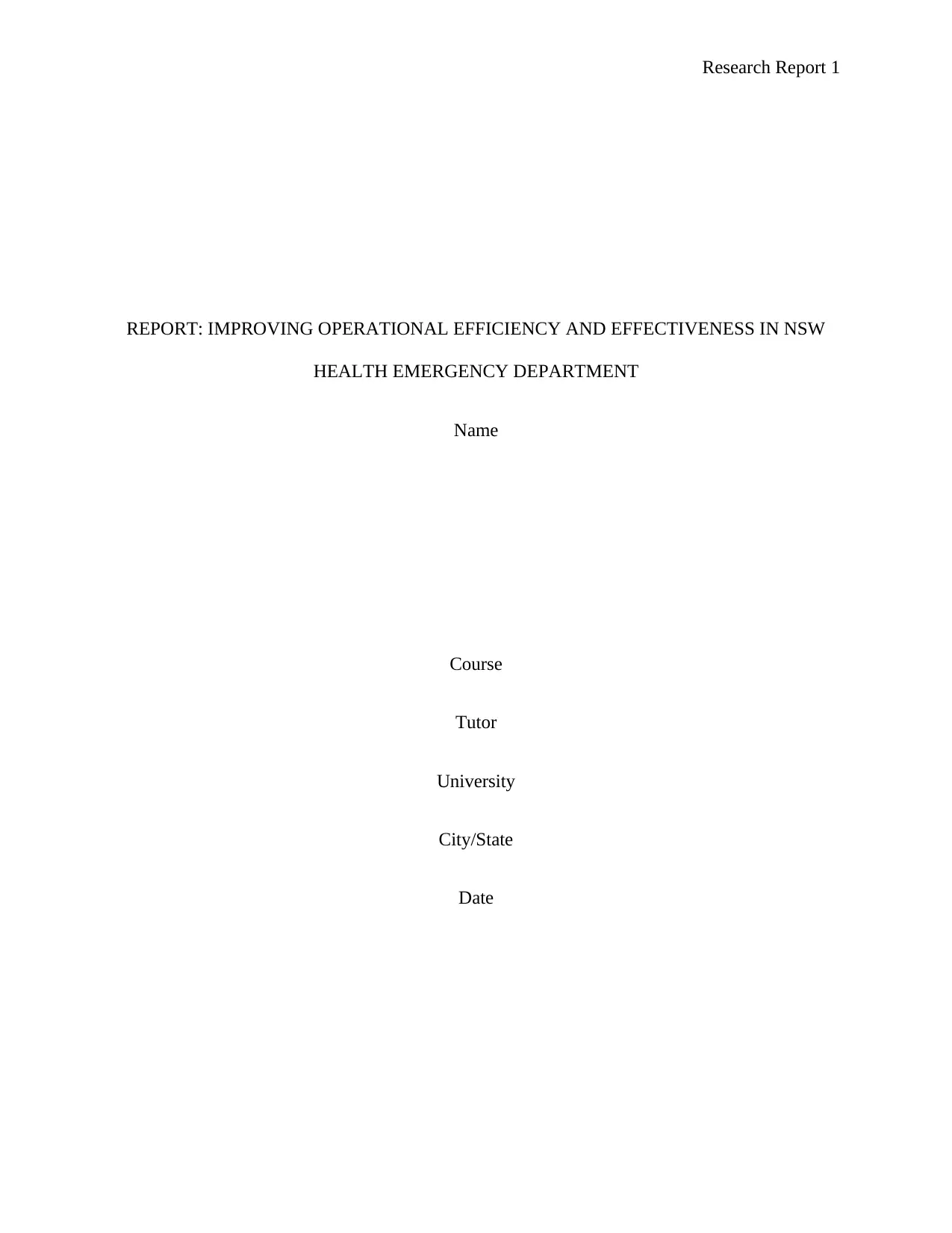
Research Report 1
REPORT: IMPROVING OPERATIONAL EFFICIENCY AND EFFECTIVENESS IN NSW
HEALTH EMERGENCY DEPARTMENT
Name
Course
Tutor
University
City/State
Date
REPORT: IMPROVING OPERATIONAL EFFICIENCY AND EFFECTIVENESS IN NSW
HEALTH EMERGENCY DEPARTMENT
Name
Course
Tutor
University
City/State
Date
Paraphrase This Document
Need a fresh take? Get an instant paraphrase of this document with our AI Paraphraser
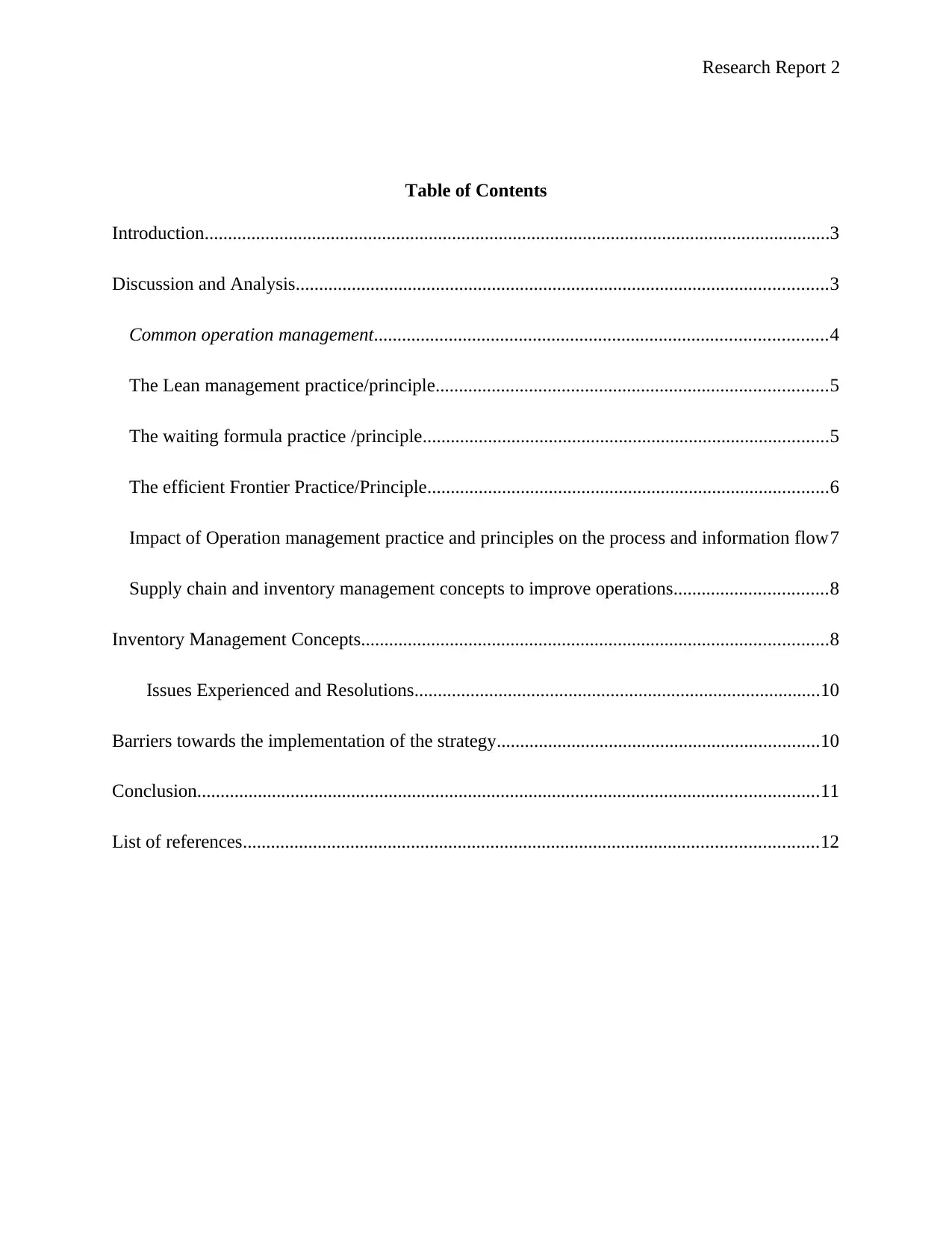
Research Report 2
Table of Contents
Introduction......................................................................................................................................3
Discussion and Analysis..................................................................................................................3
Common operation management.................................................................................................4
The Lean management practice/principle....................................................................................5
The waiting formula practice /principle.......................................................................................5
The efficient Frontier Practice/Principle......................................................................................6
Impact of Operation management practice and principles on the process and information flow7
Supply chain and inventory management concepts to improve operations.................................8
Inventory Management Concepts....................................................................................................8
Issues Experienced and Resolutions.......................................................................................10
Barriers towards the implementation of the strategy.....................................................................10
Conclusion.....................................................................................................................................11
List of references...........................................................................................................................12
Table of Contents
Introduction......................................................................................................................................3
Discussion and Analysis..................................................................................................................3
Common operation management.................................................................................................4
The Lean management practice/principle....................................................................................5
The waiting formula practice /principle.......................................................................................5
The efficient Frontier Practice/Principle......................................................................................6
Impact of Operation management practice and principles on the process and information flow7
Supply chain and inventory management concepts to improve operations.................................8
Inventory Management Concepts....................................................................................................8
Issues Experienced and Resolutions.......................................................................................10
Barriers towards the implementation of the strategy.....................................................................10
Conclusion.....................................................................................................................................11
List of references...........................................................................................................................12
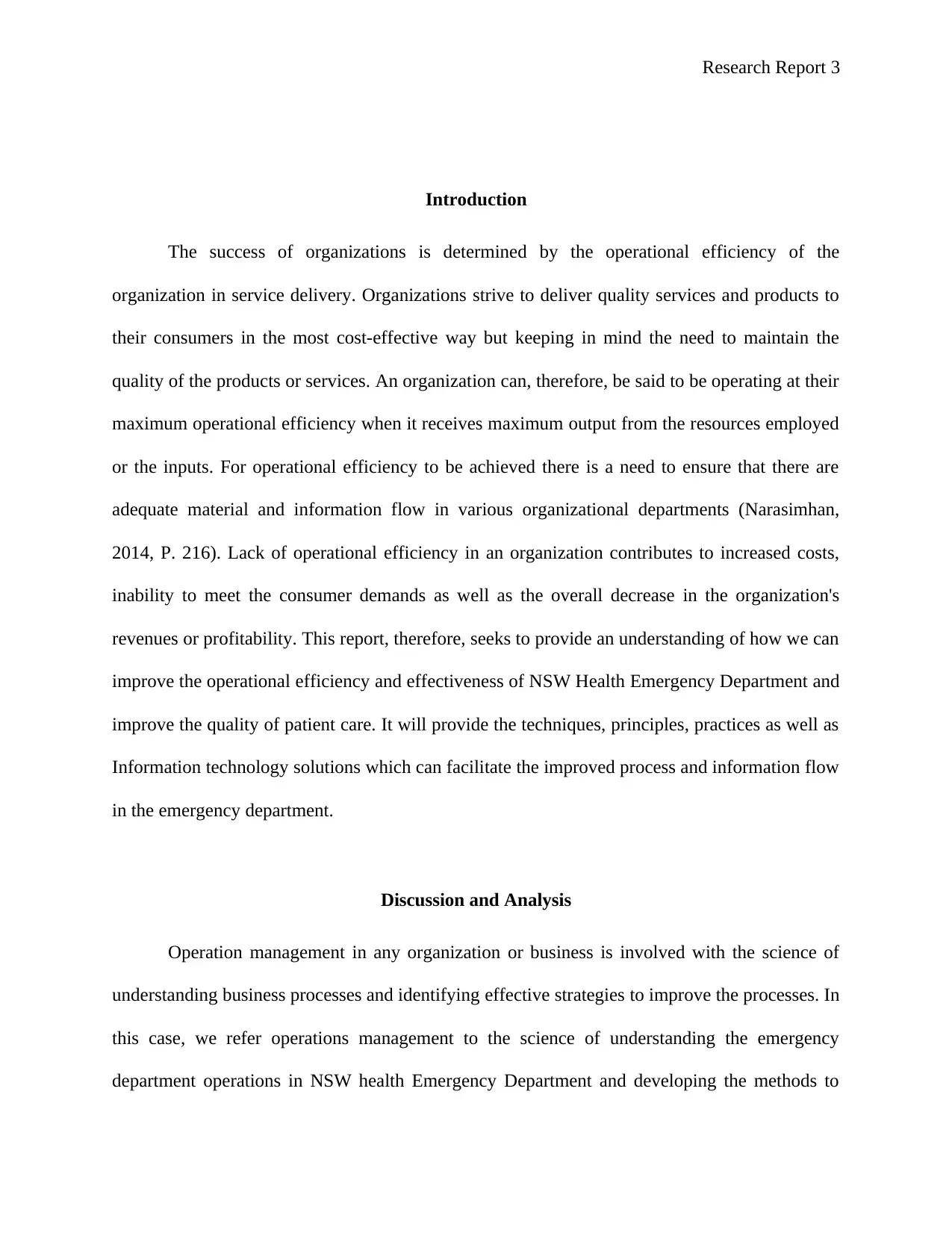
Research Report 3
Introduction
The success of organizations is determined by the operational efficiency of the
organization in service delivery. Organizations strive to deliver quality services and products to
their consumers in the most cost-effective way but keeping in mind the need to maintain the
quality of the products or services. An organization can, therefore, be said to be operating at their
maximum operational efficiency when it receives maximum output from the resources employed
or the inputs. For operational efficiency to be achieved there is a need to ensure that there are
adequate material and information flow in various organizational departments (Narasimhan,
2014, P. 216). Lack of operational efficiency in an organization contributes to increased costs,
inability to meet the consumer demands as well as the overall decrease in the organization's
revenues or profitability. This report, therefore, seeks to provide an understanding of how we can
improve the operational efficiency and effectiveness of NSW Health Emergency Department and
improve the quality of patient care. It will provide the techniques, principles, practices as well as
Information technology solutions which can facilitate the improved process and information flow
in the emergency department.
Discussion and Analysis
Operation management in any organization or business is involved with the science of
understanding business processes and identifying effective strategies to improve the processes. In
this case, we refer operations management to the science of understanding the emergency
department operations in NSW health Emergency Department and developing the methods to
Introduction
The success of organizations is determined by the operational efficiency of the
organization in service delivery. Organizations strive to deliver quality services and products to
their consumers in the most cost-effective way but keeping in mind the need to maintain the
quality of the products or services. An organization can, therefore, be said to be operating at their
maximum operational efficiency when it receives maximum output from the resources employed
or the inputs. For operational efficiency to be achieved there is a need to ensure that there are
adequate material and information flow in various organizational departments (Narasimhan,
2014, P. 216). Lack of operational efficiency in an organization contributes to increased costs,
inability to meet the consumer demands as well as the overall decrease in the organization's
revenues or profitability. This report, therefore, seeks to provide an understanding of how we can
improve the operational efficiency and effectiveness of NSW Health Emergency Department and
improve the quality of patient care. It will provide the techniques, principles, practices as well as
Information technology solutions which can facilitate the improved process and information flow
in the emergency department.
Discussion and Analysis
Operation management in any organization or business is involved with the science of
understanding business processes and identifying effective strategies to improve the processes. In
this case, we refer operations management to the science of understanding the emergency
department operations in NSW health Emergency Department and developing the methods to
⊘ This is a preview!⊘
Do you want full access?
Subscribe today to unlock all pages.

Trusted by 1+ million students worldwide
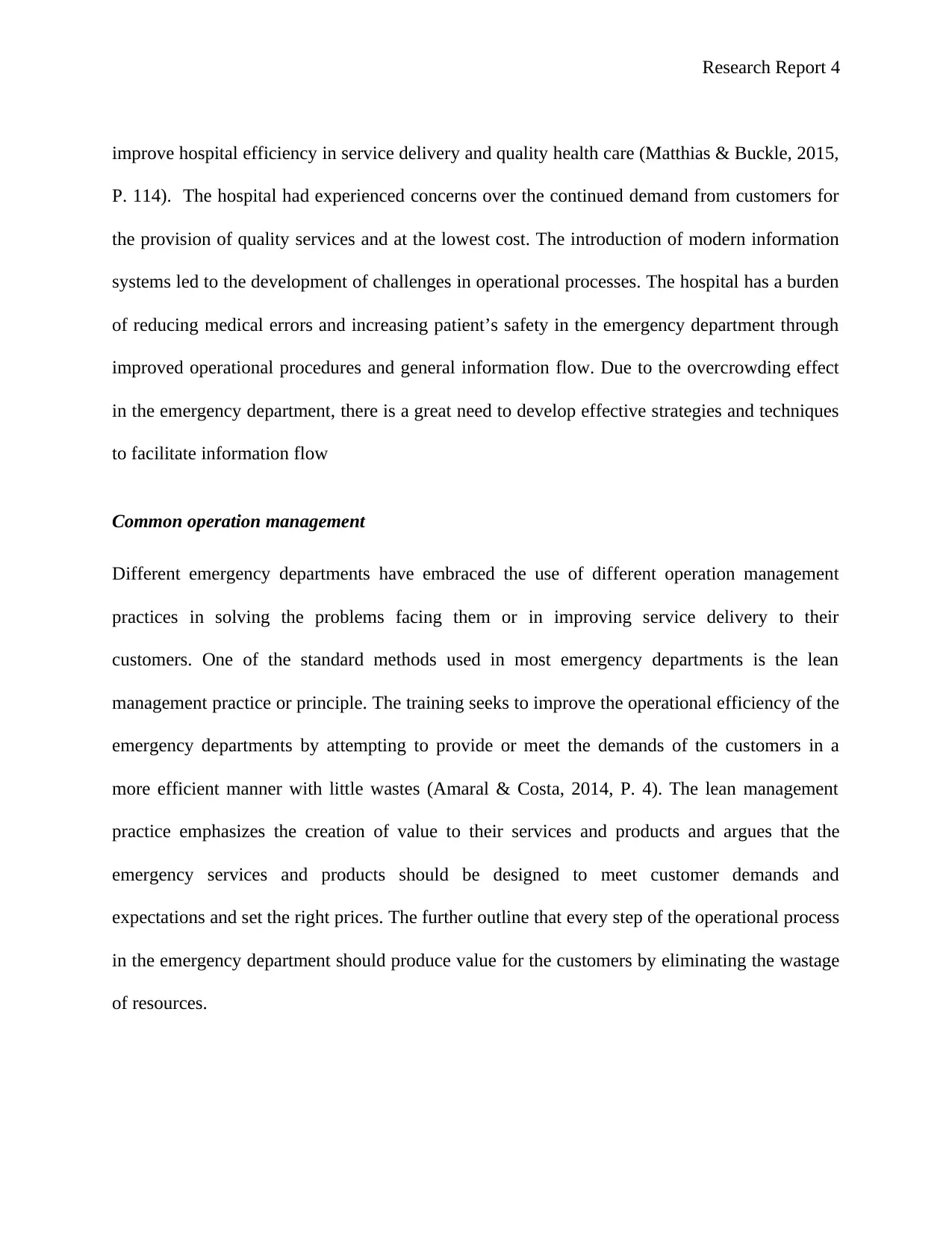
Research Report 4
improve hospital efficiency in service delivery and quality health care (Matthias & Buckle, 2015,
P. 114). The hospital had experienced concerns over the continued demand from customers for
the provision of quality services and at the lowest cost. The introduction of modern information
systems led to the development of challenges in operational processes. The hospital has a burden
of reducing medical errors and increasing patient’s safety in the emergency department through
improved operational procedures and general information flow. Due to the overcrowding effect
in the emergency department, there is a great need to develop effective strategies and techniques
to facilitate information flow
Common operation management
Different emergency departments have embraced the use of different operation management
practices in solving the problems facing them or in improving service delivery to their
customers. One of the standard methods used in most emergency departments is the lean
management practice or principle. The training seeks to improve the operational efficiency of the
emergency departments by attempting to provide or meet the demands of the customers in a
more efficient manner with little wastes (Amaral & Costa, 2014, P. 4). The lean management
practice emphasizes the creation of value to their services and products and argues that the
emergency services and products should be designed to meet customer demands and
expectations and set the right prices. The further outline that every step of the operational process
in the emergency department should produce value for the customers by eliminating the wastage
of resources.
improve hospital efficiency in service delivery and quality health care (Matthias & Buckle, 2015,
P. 114). The hospital had experienced concerns over the continued demand from customers for
the provision of quality services and at the lowest cost. The introduction of modern information
systems led to the development of challenges in operational processes. The hospital has a burden
of reducing medical errors and increasing patient’s safety in the emergency department through
improved operational procedures and general information flow. Due to the overcrowding effect
in the emergency department, there is a great need to develop effective strategies and techniques
to facilitate information flow
Common operation management
Different emergency departments have embraced the use of different operation management
practices in solving the problems facing them or in improving service delivery to their
customers. One of the standard methods used in most emergency departments is the lean
management practice or principle. The training seeks to improve the operational efficiency of the
emergency departments by attempting to provide or meet the demands of the customers in a
more efficient manner with little wastes (Amaral & Costa, 2014, P. 4). The lean management
practice emphasizes the creation of value to their services and products and argues that the
emergency services and products should be designed to meet customer demands and
expectations and set the right prices. The further outline that every step of the operational process
in the emergency department should produce value for the customers by eliminating the wastage
of resources.
Paraphrase This Document
Need a fresh take? Get an instant paraphrase of this document with our AI Paraphraser
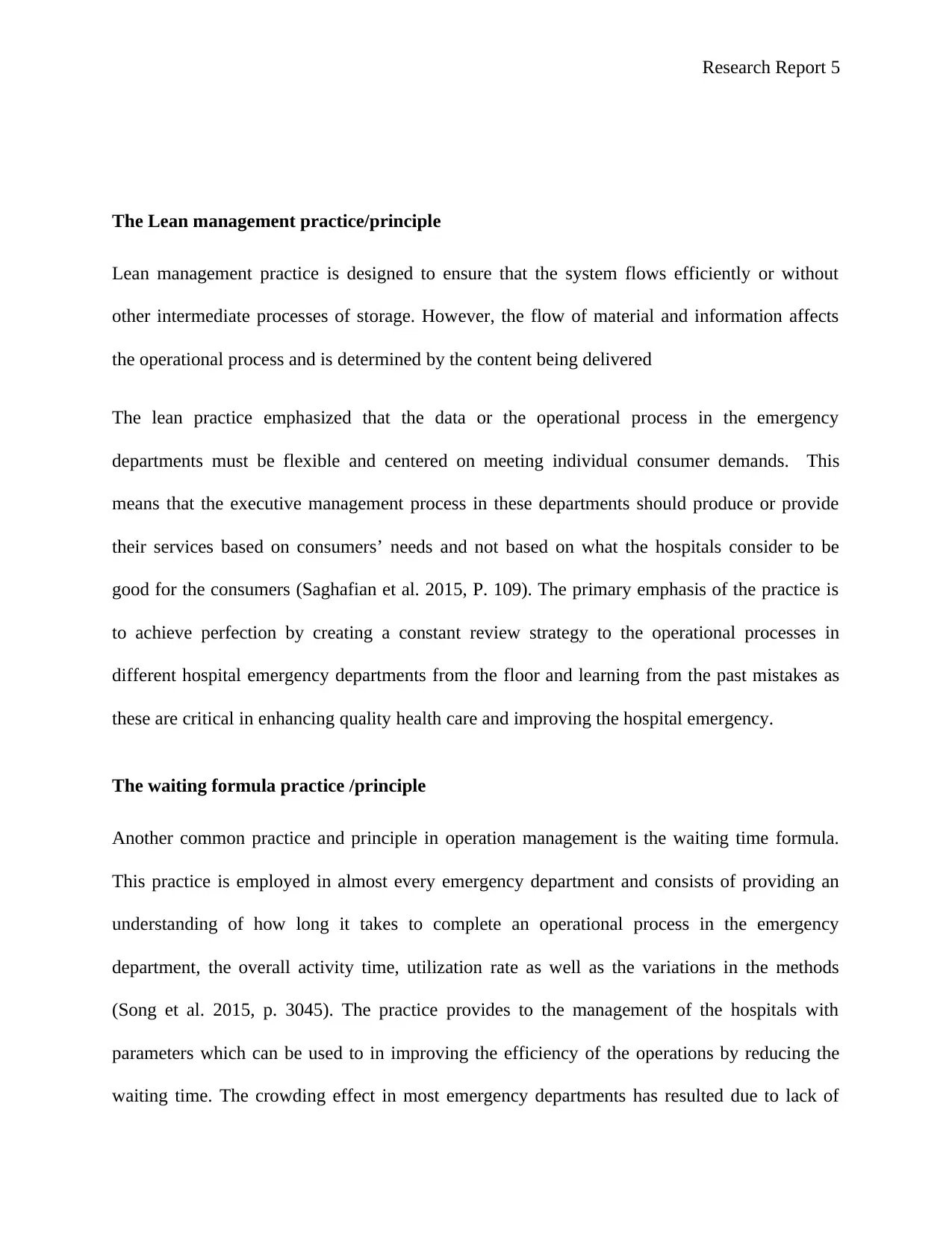
Research Report 5
The Lean management practice/principle
Lean management practice is designed to ensure that the system flows efficiently or without
other intermediate processes of storage. However, the flow of material and information affects
the operational process and is determined by the content being delivered
The lean practice emphasized that the data or the operational process in the emergency
departments must be flexible and centered on meeting individual consumer demands. This
means that the executive management process in these departments should produce or provide
their services based on consumers’ needs and not based on what the hospitals consider to be
good for the consumers (Saghafian et al. 2015, P. 109). The primary emphasis of the practice is
to achieve perfection by creating a constant review strategy to the operational processes in
different hospital emergency departments from the floor and learning from the past mistakes as
these are critical in enhancing quality health care and improving the hospital emergency.
The waiting formula practice /principle
Another common practice and principle in operation management is the waiting time formula.
This practice is employed in almost every emergency department and consists of providing an
understanding of how long it takes to complete an operational process in the emergency
department, the overall activity time, utilization rate as well as the variations in the methods
(Song et al. 2015, p. 3045). The practice provides to the management of the hospitals with
parameters which can be used to in improving the efficiency of the operations by reducing the
waiting time. The crowding effect in most emergency departments has resulted due to lack of
The Lean management practice/principle
Lean management practice is designed to ensure that the system flows efficiently or without
other intermediate processes of storage. However, the flow of material and information affects
the operational process and is determined by the content being delivered
The lean practice emphasized that the data or the operational process in the emergency
departments must be flexible and centered on meeting individual consumer demands. This
means that the executive management process in these departments should produce or provide
their services based on consumers’ needs and not based on what the hospitals consider to be
good for the consumers (Saghafian et al. 2015, P. 109). The primary emphasis of the practice is
to achieve perfection by creating a constant review strategy to the operational processes in
different hospital emergency departments from the floor and learning from the past mistakes as
these are critical in enhancing quality health care and improving the hospital emergency.
The waiting formula practice /principle
Another common practice and principle in operation management is the waiting time formula.
This practice is employed in almost every emergency department and consists of providing an
understanding of how long it takes to complete an operational process in the emergency
department, the overall activity time, utilization rate as well as the variations in the methods
(Song et al. 2015, p. 3045). The practice provides to the management of the hospitals with
parameters which can be used to in improving the efficiency of the operations by reducing the
waiting time. The crowding effect in most emergency departments has resulted due to lack of
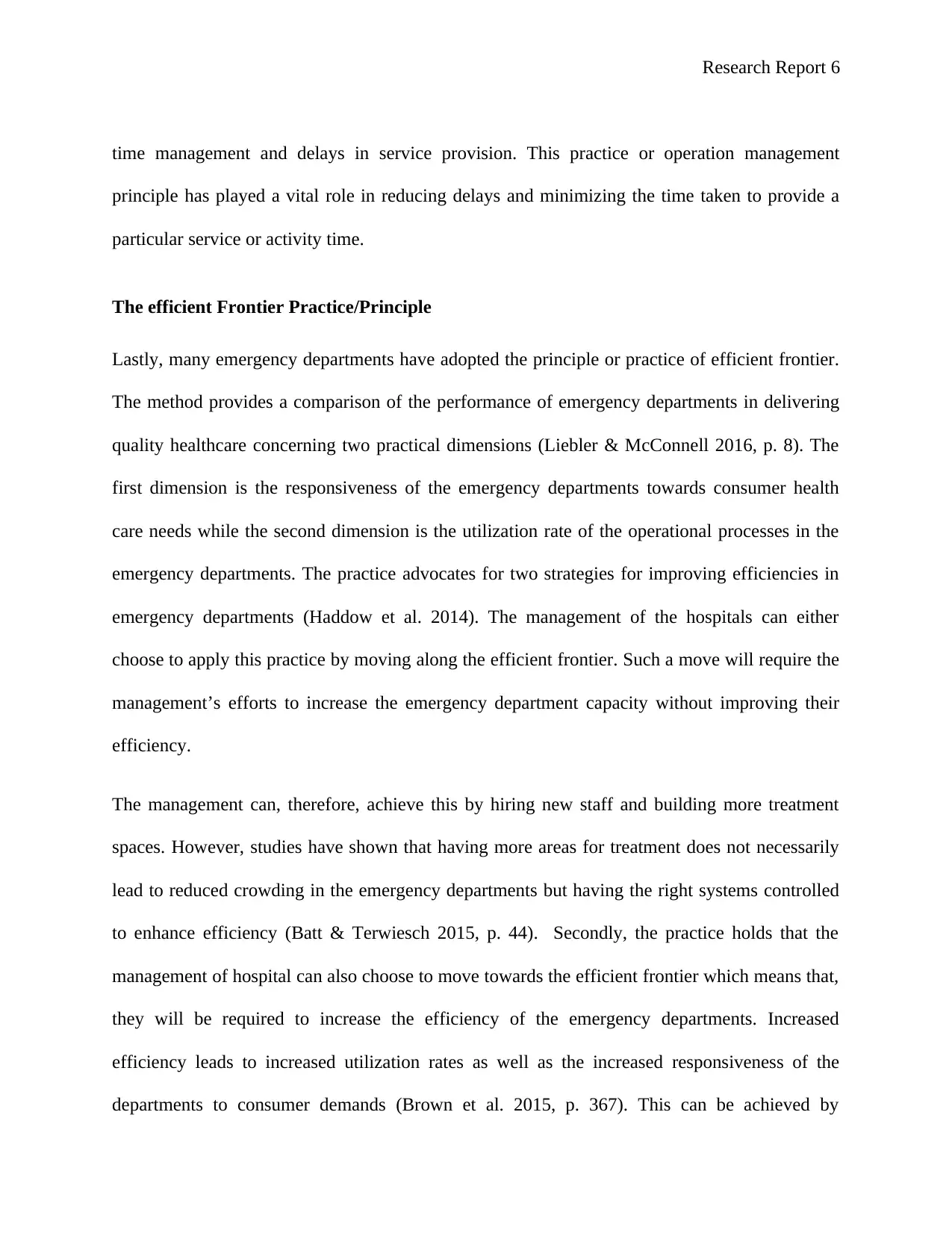
Research Report 6
time management and delays in service provision. This practice or operation management
principle has played a vital role in reducing delays and minimizing the time taken to provide a
particular service or activity time.
The efficient Frontier Practice/Principle
Lastly, many emergency departments have adopted the principle or practice of efficient frontier.
The method provides a comparison of the performance of emergency departments in delivering
quality healthcare concerning two practical dimensions (Liebler & McConnell 2016, p. 8). The
first dimension is the responsiveness of the emergency departments towards consumer health
care needs while the second dimension is the utilization rate of the operational processes in the
emergency departments. The practice advocates for two strategies for improving efficiencies in
emergency departments (Haddow et al. 2014). The management of the hospitals can either
choose to apply this practice by moving along the efficient frontier. Such a move will require the
management’s efforts to increase the emergency department capacity without improving their
efficiency.
The management can, therefore, achieve this by hiring new staff and building more treatment
spaces. However, studies have shown that having more areas for treatment does not necessarily
lead to reduced crowding in the emergency departments but having the right systems controlled
to enhance efficiency (Batt & Terwiesch 2015, p. 44). Secondly, the practice holds that the
management of hospital can also choose to move towards the efficient frontier which means that,
they will be required to increase the efficiency of the emergency departments. Increased
efficiency leads to increased utilization rates as well as the increased responsiveness of the
departments to consumer demands (Brown et al. 2015, p. 367). This can be achieved by
time management and delays in service provision. This practice or operation management
principle has played a vital role in reducing delays and minimizing the time taken to provide a
particular service or activity time.
The efficient Frontier Practice/Principle
Lastly, many emergency departments have adopted the principle or practice of efficient frontier.
The method provides a comparison of the performance of emergency departments in delivering
quality healthcare concerning two practical dimensions (Liebler & McConnell 2016, p. 8). The
first dimension is the responsiveness of the emergency departments towards consumer health
care needs while the second dimension is the utilization rate of the operational processes in the
emergency departments. The practice advocates for two strategies for improving efficiencies in
emergency departments (Haddow et al. 2014). The management of the hospitals can either
choose to apply this practice by moving along the efficient frontier. Such a move will require the
management’s efforts to increase the emergency department capacity without improving their
efficiency.
The management can, therefore, achieve this by hiring new staff and building more treatment
spaces. However, studies have shown that having more areas for treatment does not necessarily
lead to reduced crowding in the emergency departments but having the right systems controlled
to enhance efficiency (Batt & Terwiesch 2015, p. 44). Secondly, the practice holds that the
management of hospital can also choose to move towards the efficient frontier which means that,
they will be required to increase the efficiency of the emergency departments. Increased
efficiency leads to increased utilization rates as well as the increased responsiveness of the
departments to consumer demands (Brown et al. 2015, p. 367). This can be achieved by
⊘ This is a preview!⊘
Do you want full access?
Subscribe today to unlock all pages.

Trusted by 1+ million students worldwide
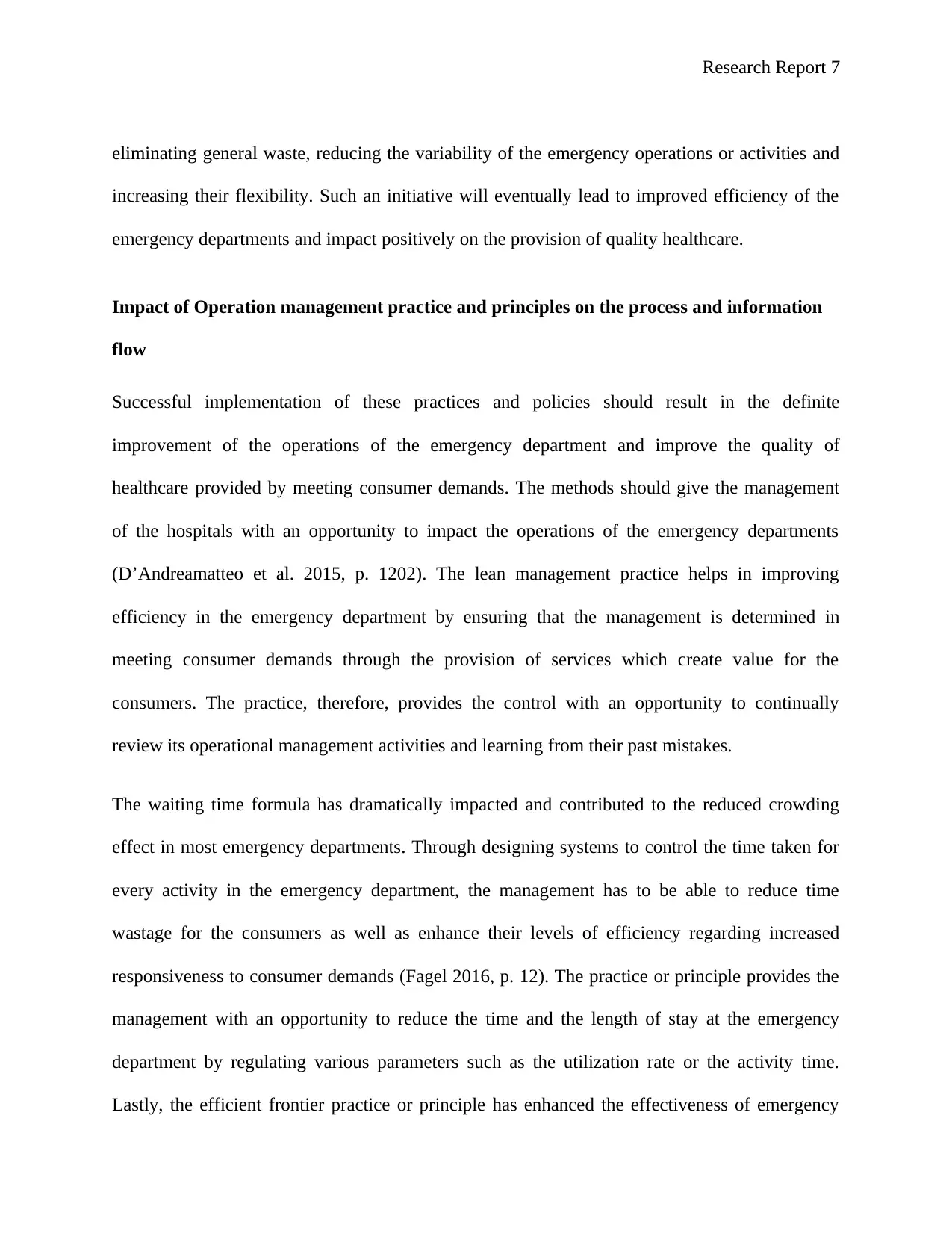
Research Report 7
eliminating general waste, reducing the variability of the emergency operations or activities and
increasing their flexibility. Such an initiative will eventually lead to improved efficiency of the
emergency departments and impact positively on the provision of quality healthcare.
Impact of Operation management practice and principles on the process and information
flow
Successful implementation of these practices and policies should result in the definite
improvement of the operations of the emergency department and improve the quality of
healthcare provided by meeting consumer demands. The methods should give the management
of the hospitals with an opportunity to impact the operations of the emergency departments
(D’Andreamatteo et al. 2015, p. 1202). The lean management practice helps in improving
efficiency in the emergency department by ensuring that the management is determined in
meeting consumer demands through the provision of services which create value for the
consumers. The practice, therefore, provides the control with an opportunity to continually
review its operational management activities and learning from their past mistakes.
The waiting time formula has dramatically impacted and contributed to the reduced crowding
effect in most emergency departments. Through designing systems to control the time taken for
every activity in the emergency department, the management has to be able to reduce time
wastage for the consumers as well as enhance their levels of efficiency regarding increased
responsiveness to consumer demands (Fagel 2016, p. 12). The practice or principle provides the
management with an opportunity to reduce the time and the length of stay at the emergency
department by regulating various parameters such as the utilization rate or the activity time.
Lastly, the efficient frontier practice or principle has enhanced the effectiveness of emergency
eliminating general waste, reducing the variability of the emergency operations or activities and
increasing their flexibility. Such an initiative will eventually lead to improved efficiency of the
emergency departments and impact positively on the provision of quality healthcare.
Impact of Operation management practice and principles on the process and information
flow
Successful implementation of these practices and policies should result in the definite
improvement of the operations of the emergency department and improve the quality of
healthcare provided by meeting consumer demands. The methods should give the management
of the hospitals with an opportunity to impact the operations of the emergency departments
(D’Andreamatteo et al. 2015, p. 1202). The lean management practice helps in improving
efficiency in the emergency department by ensuring that the management is determined in
meeting consumer demands through the provision of services which create value for the
consumers. The practice, therefore, provides the control with an opportunity to continually
review its operational management activities and learning from their past mistakes.
The waiting time formula has dramatically impacted and contributed to the reduced crowding
effect in most emergency departments. Through designing systems to control the time taken for
every activity in the emergency department, the management has to be able to reduce time
wastage for the consumers as well as enhance their levels of efficiency regarding increased
responsiveness to consumer demands (Fagel 2016, p. 12). The practice or principle provides the
management with an opportunity to reduce the time and the length of stay at the emergency
department by regulating various parameters such as the utilization rate or the activity time.
Lastly, the efficient frontier practice or principle has enhanced the effectiveness of emergency
Paraphrase This Document
Need a fresh take? Get an instant paraphrase of this document with our AI Paraphraser
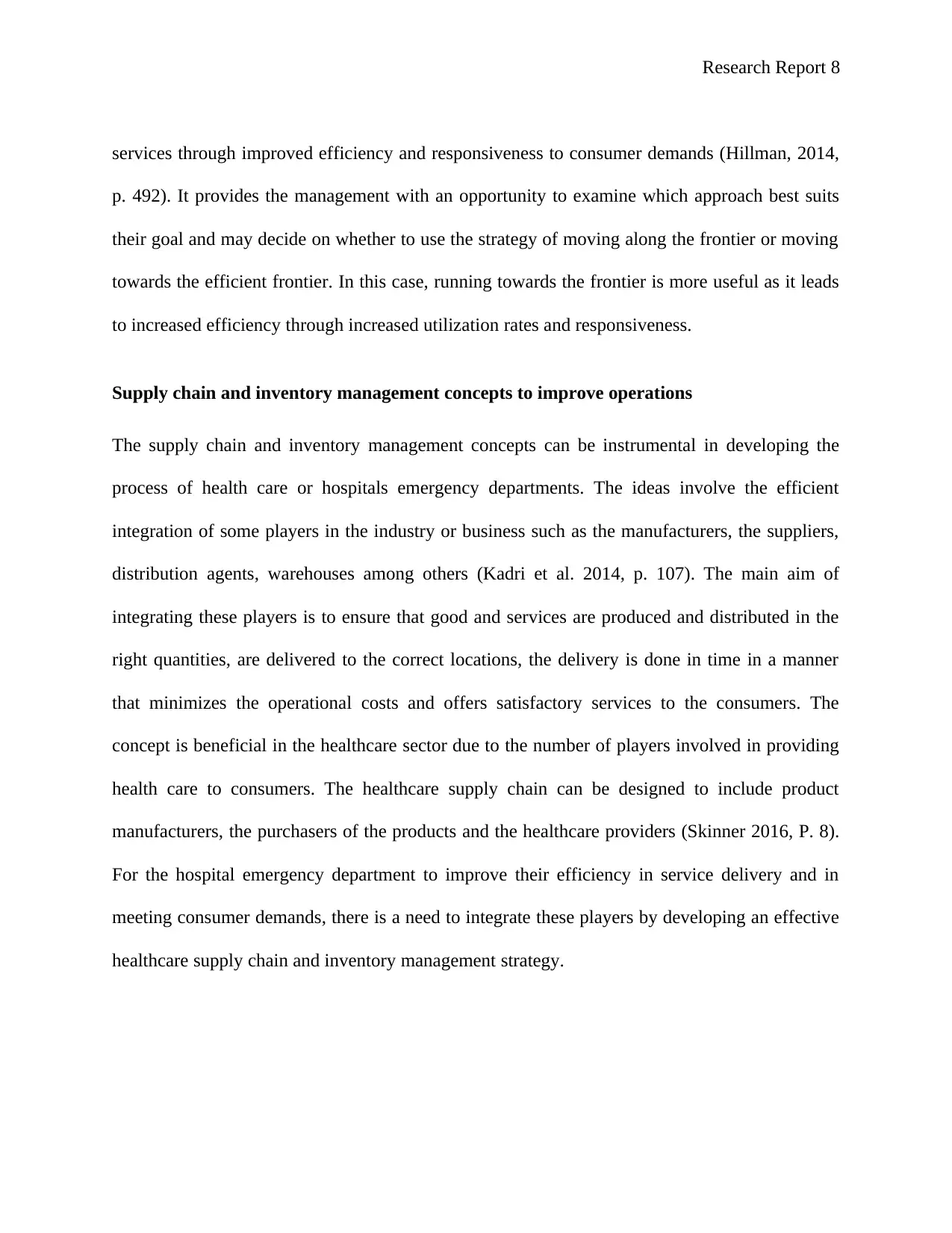
Research Report 8
services through improved efficiency and responsiveness to consumer demands (Hillman, 2014,
p. 492). It provides the management with an opportunity to examine which approach best suits
their goal and may decide on whether to use the strategy of moving along the frontier or moving
towards the efficient frontier. In this case, running towards the frontier is more useful as it leads
to increased efficiency through increased utilization rates and responsiveness.
Supply chain and inventory management concepts to improve operations
The supply chain and inventory management concepts can be instrumental in developing the
process of health care or hospitals emergency departments. The ideas involve the efficient
integration of some players in the industry or business such as the manufacturers, the suppliers,
distribution agents, warehouses among others (Kadri et al. 2014, p. 107). The main aim of
integrating these players is to ensure that good and services are produced and distributed in the
right quantities, are delivered to the correct locations, the delivery is done in time in a manner
that minimizes the operational costs and offers satisfactory services to the consumers. The
concept is beneficial in the healthcare sector due to the number of players involved in providing
health care to consumers. The healthcare supply chain can be designed to include product
manufacturers, the purchasers of the products and the healthcare providers (Skinner 2016, P. 8).
For the hospital emergency department to improve their efficiency in service delivery and in
meeting consumer demands, there is a need to integrate these players by developing an effective
healthcare supply chain and inventory management strategy.
services through improved efficiency and responsiveness to consumer demands (Hillman, 2014,
p. 492). It provides the management with an opportunity to examine which approach best suits
their goal and may decide on whether to use the strategy of moving along the frontier or moving
towards the efficient frontier. In this case, running towards the frontier is more useful as it leads
to increased efficiency through increased utilization rates and responsiveness.
Supply chain and inventory management concepts to improve operations
The supply chain and inventory management concepts can be instrumental in developing the
process of health care or hospitals emergency departments. The ideas involve the efficient
integration of some players in the industry or business such as the manufacturers, the suppliers,
distribution agents, warehouses among others (Kadri et al. 2014, p. 107). The main aim of
integrating these players is to ensure that good and services are produced and distributed in the
right quantities, are delivered to the correct locations, the delivery is done in time in a manner
that minimizes the operational costs and offers satisfactory services to the consumers. The
concept is beneficial in the healthcare sector due to the number of players involved in providing
health care to consumers. The healthcare supply chain can be designed to include product
manufacturers, the purchasers of the products and the healthcare providers (Skinner 2016, P. 8).
For the hospital emergency department to improve their efficiency in service delivery and in
meeting consumer demands, there is a need to integrate these players by developing an effective
healthcare supply chain and inventory management strategy.
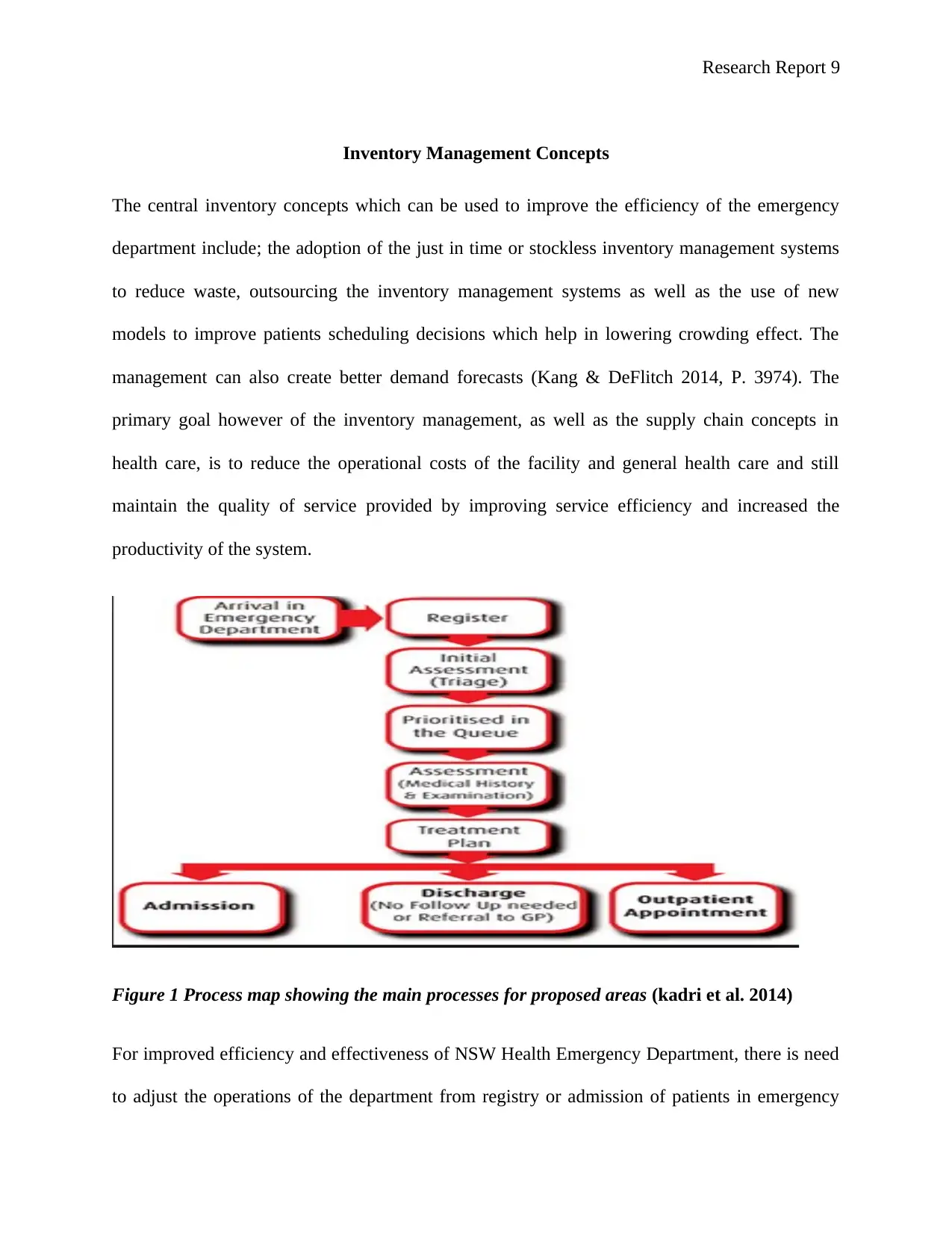
Research Report 9
Inventory Management Concepts
The central inventory concepts which can be used to improve the efficiency of the emergency
department include; the adoption of the just in time or stockless inventory management systems
to reduce waste, outsourcing the inventory management systems as well as the use of new
models to improve patients scheduling decisions which help in lowering crowding effect. The
management can also create better demand forecasts (Kang & DeFlitch 2014, P. 3974). The
primary goal however of the inventory management, as well as the supply chain concepts in
health care, is to reduce the operational costs of the facility and general health care and still
maintain the quality of service provided by improving service efficiency and increased the
productivity of the system.
Figure 1 Process map showing the main processes for proposed areas (kadri et al. 2014)
For improved efficiency and effectiveness of NSW Health Emergency Department, there is need
to adjust the operations of the department from registry or admission of patients in emergency
Inventory Management Concepts
The central inventory concepts which can be used to improve the efficiency of the emergency
department include; the adoption of the just in time or stockless inventory management systems
to reduce waste, outsourcing the inventory management systems as well as the use of new
models to improve patients scheduling decisions which help in lowering crowding effect. The
management can also create better demand forecasts (Kang & DeFlitch 2014, P. 3974). The
primary goal however of the inventory management, as well as the supply chain concepts in
health care, is to reduce the operational costs of the facility and general health care and still
maintain the quality of service provided by improving service efficiency and increased the
productivity of the system.
Figure 1 Process map showing the main processes for proposed areas (kadri et al. 2014)
For improved efficiency and effectiveness of NSW Health Emergency Department, there is need
to adjust the operations of the department from registry or admission of patients in emergency
⊘ This is a preview!⊘
Do you want full access?
Subscribe today to unlock all pages.

Trusted by 1+ million students worldwide
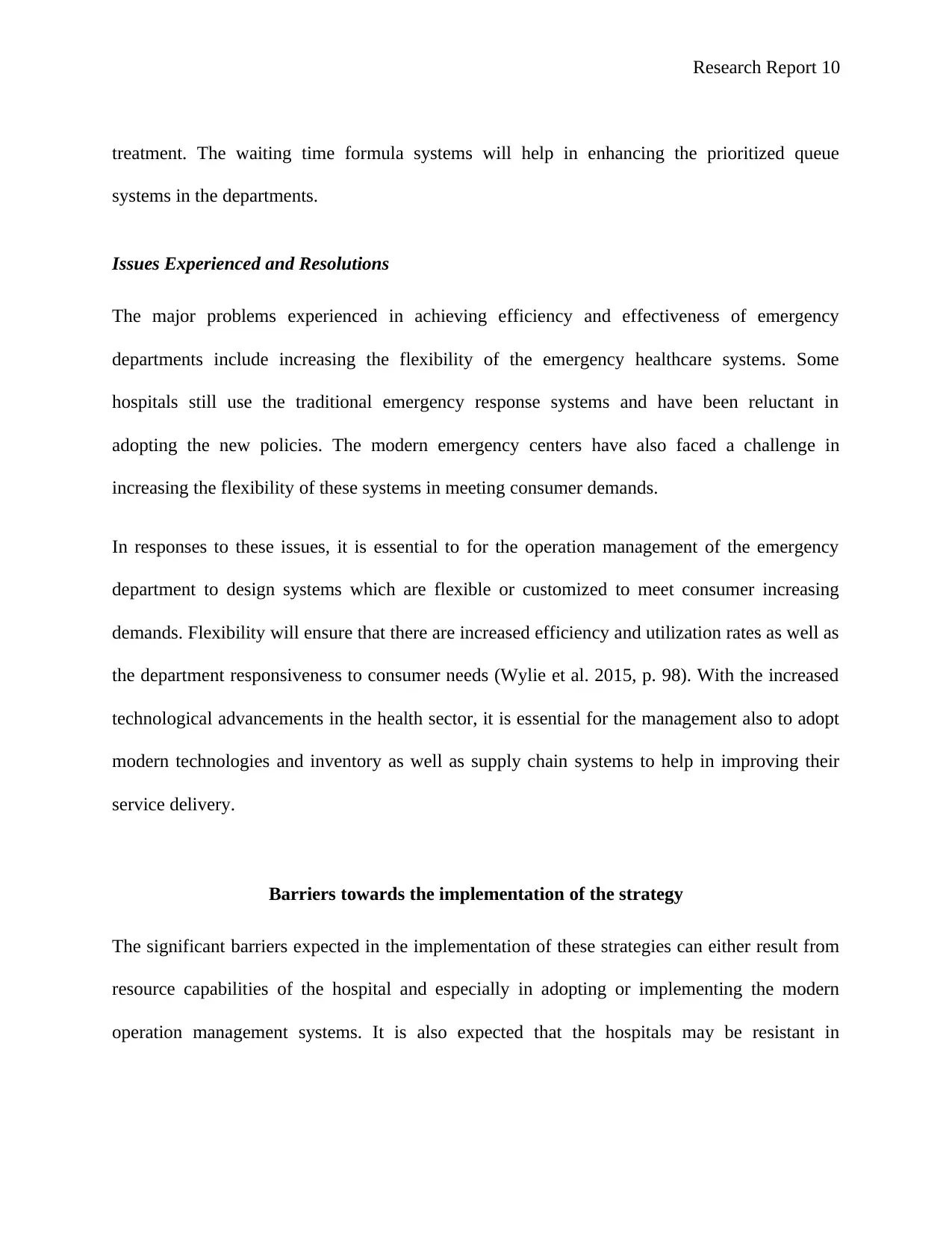
Research Report 10
treatment. The waiting time formula systems will help in enhancing the prioritized queue
systems in the departments.
Issues Experienced and Resolutions
The major problems experienced in achieving efficiency and effectiveness of emergency
departments include increasing the flexibility of the emergency healthcare systems. Some
hospitals still use the traditional emergency response systems and have been reluctant in
adopting the new policies. The modern emergency centers have also faced a challenge in
increasing the flexibility of these systems in meeting consumer demands.
In responses to these issues, it is essential to for the operation management of the emergency
department to design systems which are flexible or customized to meet consumer increasing
demands. Flexibility will ensure that there are increased efficiency and utilization rates as well as
the department responsiveness to consumer needs (Wylie et al. 2015, p. 98). With the increased
technological advancements in the health sector, it is essential for the management also to adopt
modern technologies and inventory as well as supply chain systems to help in improving their
service delivery.
Barriers towards the implementation of the strategy
The significant barriers expected in the implementation of these strategies can either result from
resource capabilities of the hospital and especially in adopting or implementing the modern
operation management systems. It is also expected that the hospitals may be resistant in
treatment. The waiting time formula systems will help in enhancing the prioritized queue
systems in the departments.
Issues Experienced and Resolutions
The major problems experienced in achieving efficiency and effectiveness of emergency
departments include increasing the flexibility of the emergency healthcare systems. Some
hospitals still use the traditional emergency response systems and have been reluctant in
adopting the new policies. The modern emergency centers have also faced a challenge in
increasing the flexibility of these systems in meeting consumer demands.
In responses to these issues, it is essential to for the operation management of the emergency
department to design systems which are flexible or customized to meet consumer increasing
demands. Flexibility will ensure that there are increased efficiency and utilization rates as well as
the department responsiveness to consumer needs (Wylie et al. 2015, p. 98). With the increased
technological advancements in the health sector, it is essential for the management also to adopt
modern technologies and inventory as well as supply chain systems to help in improving their
service delivery.
Barriers towards the implementation of the strategy
The significant barriers expected in the implementation of these strategies can either result from
resource capabilities of the hospital and especially in adopting or implementing the modern
operation management systems. It is also expected that the hospitals may be resistant in
Paraphrase This Document
Need a fresh take? Get an instant paraphrase of this document with our AI Paraphraser
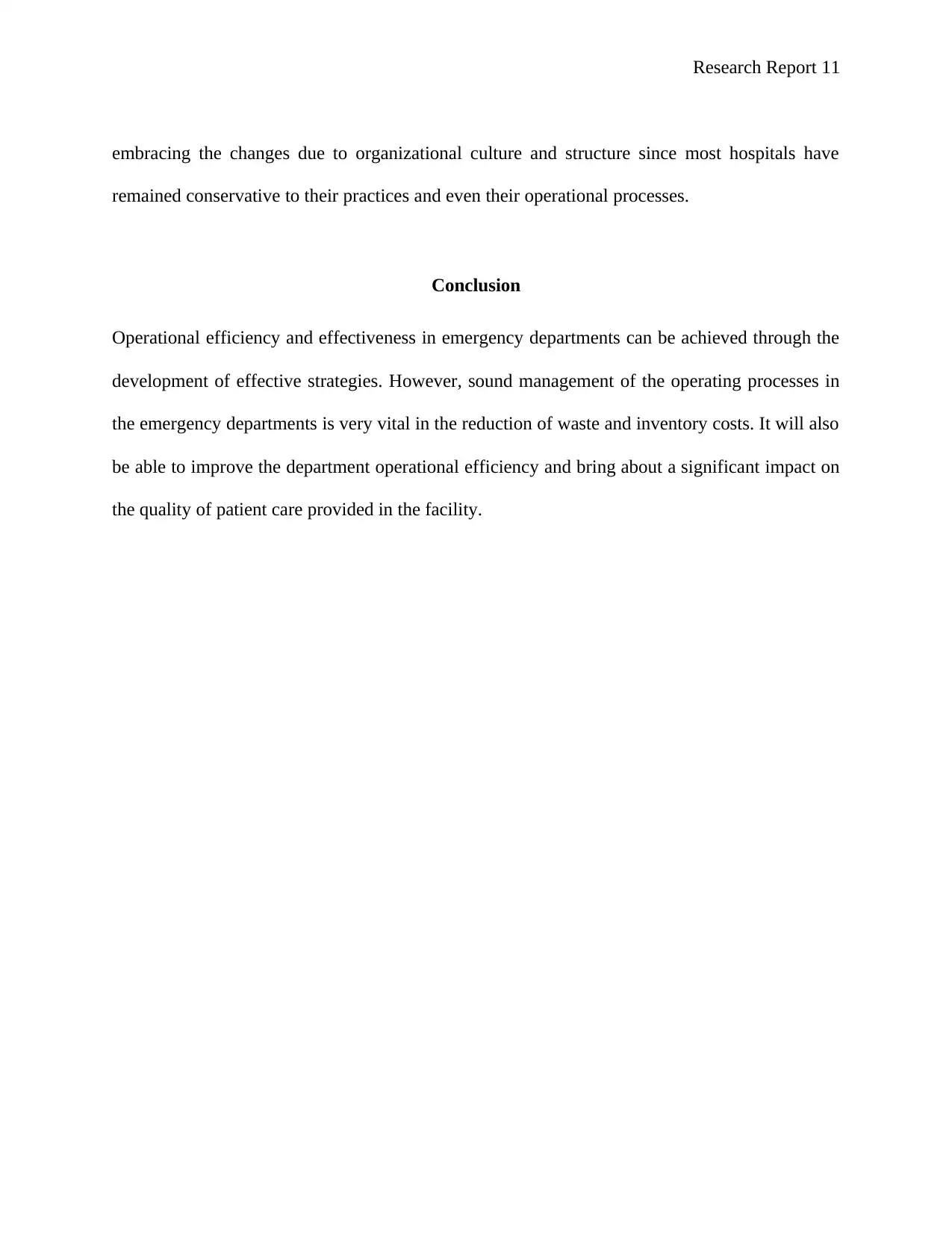
Research Report 11
embracing the changes due to organizational culture and structure since most hospitals have
remained conservative to their practices and even their operational processes.
Conclusion
Operational efficiency and effectiveness in emergency departments can be achieved through the
development of effective strategies. However, sound management of the operating processes in
the emergency departments is very vital in the reduction of waste and inventory costs. It will also
be able to improve the department operational efficiency and bring about a significant impact on
the quality of patient care provided in the facility.
embracing the changes due to organizational culture and structure since most hospitals have
remained conservative to their practices and even their operational processes.
Conclusion
Operational efficiency and effectiveness in emergency departments can be achieved through the
development of effective strategies. However, sound management of the operating processes in
the emergency departments is very vital in the reduction of waste and inventory costs. It will also
be able to improve the department operational efficiency and bring about a significant impact on
the quality of patient care provided in the facility.
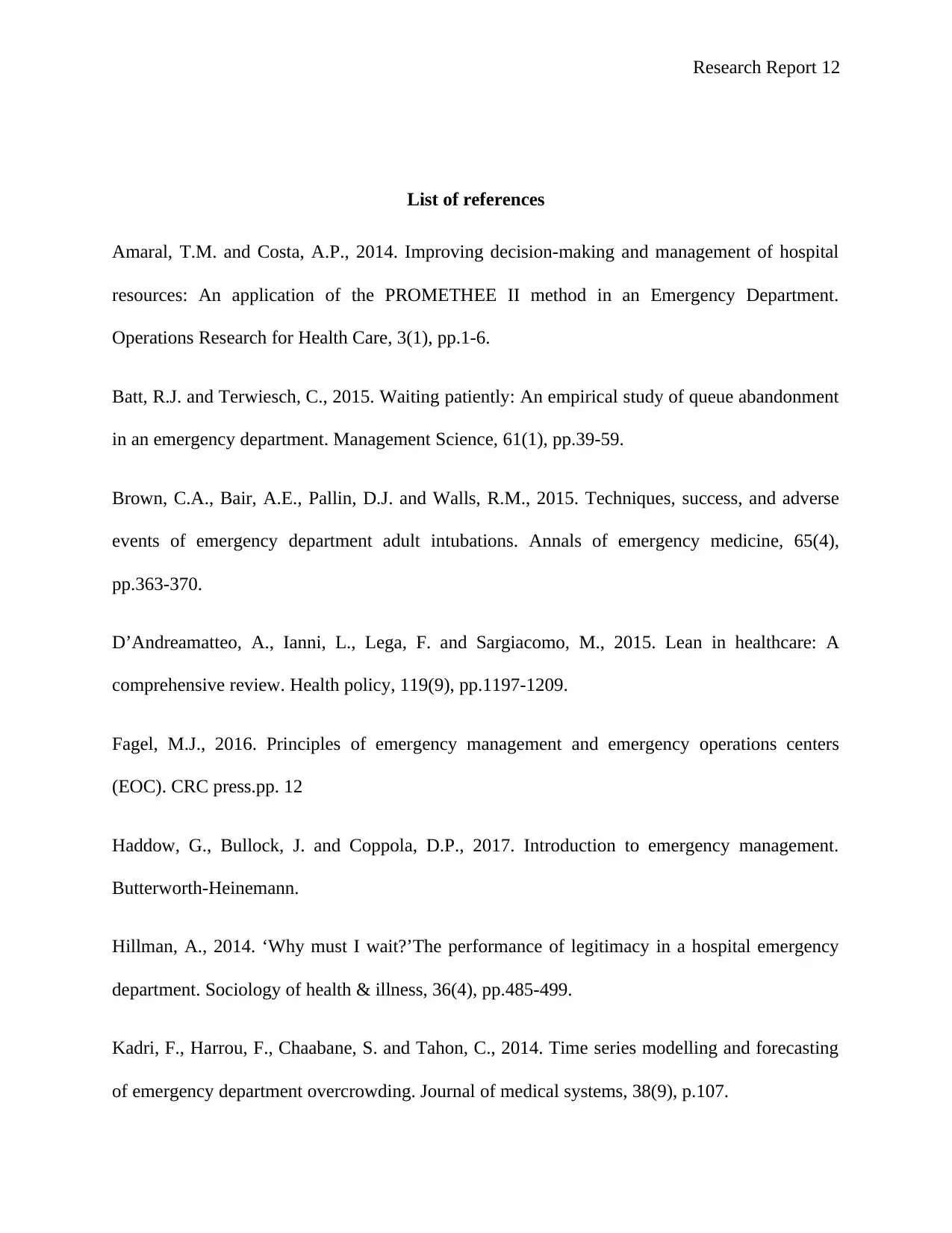
Research Report 12
List of references
Amaral, T.M. and Costa, A.P., 2014. Improving decision-making and management of hospital
resources: An application of the PROMETHEE II method in an Emergency Department.
Operations Research for Health Care, 3(1), pp.1-6.
Batt, R.J. and Terwiesch, C., 2015. Waiting patiently: An empirical study of queue abandonment
in an emergency department. Management Science, 61(1), pp.39-59.
Brown, C.A., Bair, A.E., Pallin, D.J. and Walls, R.M., 2015. Techniques, success, and adverse
events of emergency department adult intubations. Annals of emergency medicine, 65(4),
pp.363-370.
D’Andreamatteo, A., Ianni, L., Lega, F. and Sargiacomo, M., 2015. Lean in healthcare: A
comprehensive review. Health policy, 119(9), pp.1197-1209.
Fagel, M.J., 2016. Principles of emergency management and emergency operations centers
(EOC). CRC press.pp. 12
Haddow, G., Bullock, J. and Coppola, D.P., 2017. Introduction to emergency management.
Butterworth-Heinemann.
Hillman, A., 2014. ‘Why must I wait?’The performance of legitimacy in a hospital emergency
department. Sociology of health & illness, 36(4), pp.485-499.
Kadri, F., Harrou, F., Chaabane, S. and Tahon, C., 2014. Time series modelling and forecasting
of emergency department overcrowding. Journal of medical systems, 38(9), p.107.
List of references
Amaral, T.M. and Costa, A.P., 2014. Improving decision-making and management of hospital
resources: An application of the PROMETHEE II method in an Emergency Department.
Operations Research for Health Care, 3(1), pp.1-6.
Batt, R.J. and Terwiesch, C., 2015. Waiting patiently: An empirical study of queue abandonment
in an emergency department. Management Science, 61(1), pp.39-59.
Brown, C.A., Bair, A.E., Pallin, D.J. and Walls, R.M., 2015. Techniques, success, and adverse
events of emergency department adult intubations. Annals of emergency medicine, 65(4),
pp.363-370.
D’Andreamatteo, A., Ianni, L., Lega, F. and Sargiacomo, M., 2015. Lean in healthcare: A
comprehensive review. Health policy, 119(9), pp.1197-1209.
Fagel, M.J., 2016. Principles of emergency management and emergency operations centers
(EOC). CRC press.pp. 12
Haddow, G., Bullock, J. and Coppola, D.P., 2017. Introduction to emergency management.
Butterworth-Heinemann.
Hillman, A., 2014. ‘Why must I wait?’The performance of legitimacy in a hospital emergency
department. Sociology of health & illness, 36(4), pp.485-499.
Kadri, F., Harrou, F., Chaabane, S. and Tahon, C., 2014. Time series modelling and forecasting
of emergency department overcrowding. Journal of medical systems, 38(9), p.107.
⊘ This is a preview!⊘
Do you want full access?
Subscribe today to unlock all pages.

Trusted by 1+ million students worldwide
1 out of 13
Related Documents
Your All-in-One AI-Powered Toolkit for Academic Success.
+13062052269
info@desklib.com
Available 24*7 on WhatsApp / Email
![[object Object]](/_next/static/media/star-bottom.7253800d.svg)
Unlock your academic potential
Copyright © 2020–2025 A2Z Services. All Rights Reserved. Developed and managed by ZUCOL.





